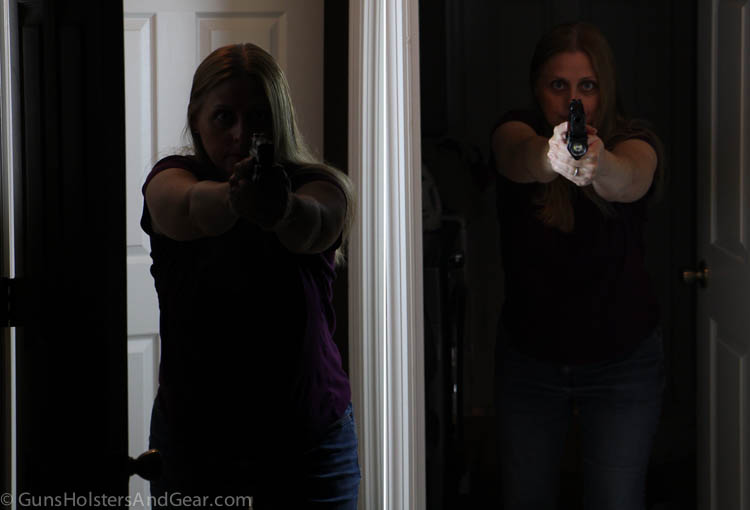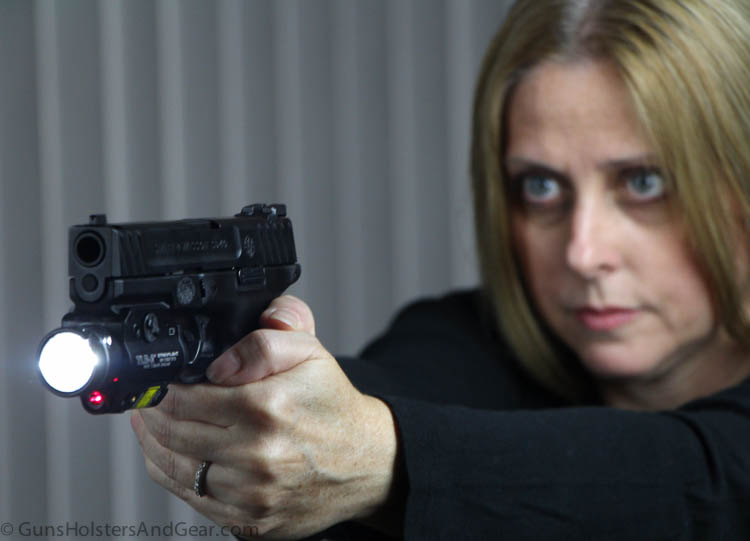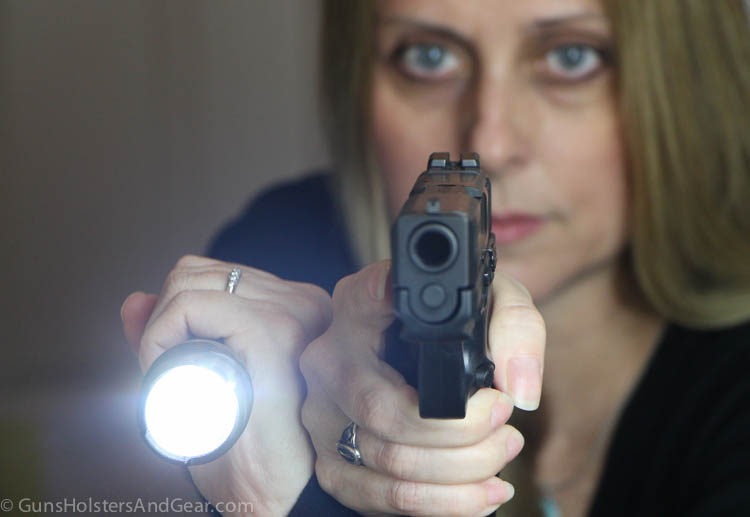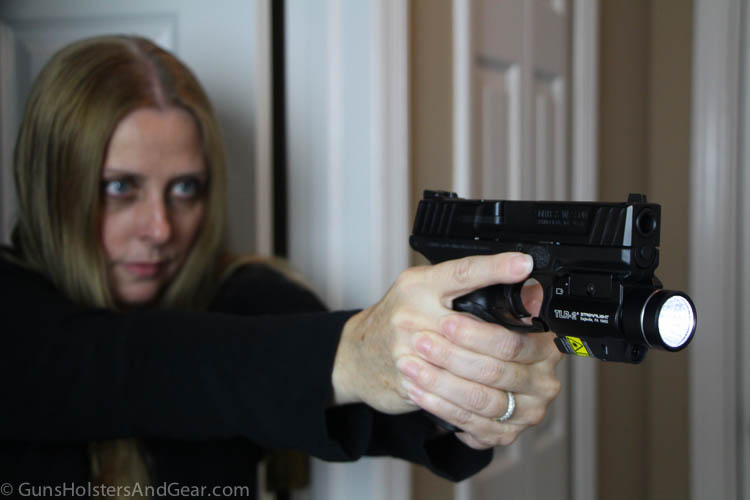When seeking out things that go bump in the night, a homeowner needs the right tools and skills to safely identify and address any threats that may present themselves. A flashlight is a critical survival tool, as is competency in its use.
The flashlight serves three basic purposes in a home defense situation: navigation, identification of threats and the engagement of threats. No technique or tool is perfect. Some techniques work well for one group of people, but not as well for others. There are no absolutes. Each person must find the right tools and training, and then practice with them.
The following article are the things that I have found work well for me. For new readers who do not know me, I spent more than 10 years in police work as a uniformed patrol officer. Most of that time was on midnights and evening shifts. I got a lot of experience in using a flashlight in all kinds of situations and was fortunate enough to attend some advanced training on the topic.
With the training and experience, I worked out a variety of techniques that worked for me. These techniques may not work as well for you. The key is to try them and find out. Do not wait until you are in a perilous situation to figure out that something won’t work for you.
Navigation
Moving through a dark house can be difficult under the best of circumstances. Doing so while checking for a possible home invader at 2 a.m. can prove to be exceptionally tough. Having enough light can prevent a homeowner from walking into a wall, or tripping over a child’s toy. If you’ve never stepped on a Lego block with a bare foot, you don’t know what pain is.
Many homes have a certain amount of ambient light from electronic devices such as DVD players, computers and digital clocks. If your eyes are adjusted to the darkness, these ambient lights can be enough for a homeowner to safely navigate through common areas.
A flashlight can provide you with additional navigation light and supplement other existing lights in the home. Some areas, such as a bedroom or garage, may not have any ambient illumination and you will have to introduce light into the room to navigate.
Unless you know that a deadly force threat exists, it is preferable to navigate with a handheld flashlight, and not a weapon light. In the vast majority of cases when a homeowner checks on an unusual noise, the source of the concern is another family member, a pet or something else other than an intruder. Using a handheld flashlight, instead of a weapon light, is one step you can take to avoid a tragedy.
Use the flashlight sparingly. If your eyes have acclimated to the darkness, turning on the flashlight can partially rob you of that adaptation. That means when you turn the flashlight off, you will not be able to see as well in the ambient light as you had prior to turning the flashlight on.
Generally, leaving the flashlight on and moving through the darkness will put you at a tactical disadvantage if there is an intruder. The light will catch the intruder’s attention and leaving it on will give him a fix on your position.
When you need to turn the light on, do so briefly. As soon as you turn the light off, you should move to a new position. Darkness will help conceal your movement and new position.
You can also hold the flashlight away from your body when turning it on. This can mislead an intruder on your actual position. While not an optimal technique for shooting with the flashlight, it can offer some margin of additional safety when navigating an area.

A homeowner can also use normal household lights to illuminate a room. You just have to be careful to illuminate the areas in front of you, not behind. If you move toward a darkened area with light behind you, you create a nearly perfect silhouette target for any armed intruder.
In the above photo, you can see the difference between being backlit and having the light in front of you. When backlit, you make a very easy to see target. When moving from darkness toward the light, you are less easily seen when you remain in the shadows.
Identifying Threats
Threat identification is critical. Failing to recognize a lethal threat could result in your injury or death. Conversely, misidentifying something as a threat when it is not could have even more tragic consequences. Too many times have I read a story in the newspaper about a homeowner having shot a family member he or she thought was an intruder.
In low light situations, the probability of misidentifying threats is very high. Before you pull the trigger, you must know that the person you are shooting is an imminent threat. Using a bright flashlight is one way to positively identify something or someone as an actual threat.
How bright is bright enough? For checking the interior of a typical home, I have found that lights rated at about 200 lumens from reputable companies will serve you very well. This is a general rule of thumb, and you should not automatically discount a light with a lower rating if it otherwise meets your needs. There are many good options in the 80-100 lumen range.
Note that the lumens rating is not the only important measurement for a tactical flashlight. Please go over to my flashlight review page and read through the explanations there. There is, unfortunately, a lot of misleading information offered up by unscrupulous manufacturers. Hence, I’ve taken to testing of flashlights in controlled conditions and provide that data in my reviews.

When checking an area for possible threats, using a handheld light is best to avoid an unintentional shooting. When startled, the hands can clench. If you are searching an area with a light mounted on your firearm, the clenching of the hands could cause you to pull the trigger. If you are searching an area for a known threat, using the weapon-mounted light becomes a more reasonable choice.
Engaging Threats
If you have encountered an armed intruder and you must shoot to save your life, using a flashlight can improve your ability to put rounds on target and stop the threat. Firearms instructors have wrestled with the problem of bringing light to a nighttime gunfight.
There are a number of different methods that have been developed, some that require specialized tools. Through personal experience and training, I have found three that tend to work best for me: the Harries technique, the neck index and the weapon-mounted light.
Harries Technique
Using the Harries Technique, or Harries Method, the homeowner obtains a good one-hand grip on the handgun and extends the pistol away from the body. With the opposite hand, the shooter grasps a handheld flashlight in his fist so that the thumb is toward the shooter’s body. The flashlight hand then comes under the shooting arm and the backs of the hands meet at the extended position.

The backs of the hands and wrists exert force toward the other, creating isometric tension and a relatively stable shooting platform. This technique works well for shooters used to the Weaver stance.
The Harries Technique works best when the shooter has a small flashlight that has a switch on the tailcap. However, a shooter can also use a longer flashlight, such as a Maglite, and rest the long body on the forearm of the gun hand to minimize fatigue.
Neck Index

This is a one hand shooting technique where the flashlight is held by the non-shooting hand near the neck or face. This is a very easy method to learn, and it works well in many cases. Wherever the eyes go, the flashlight goes with them. One of the advantages to this method is that the shooter will be able to see the sights on a handgun and use them if needed.
Weapon-Mounted Light
A light mounted on a firearm has multiple distinct advantages over handheld flashlights. One of the most obvious is it allows the shooter to have a two-handed grip on the weapon. Also, at relatively close ranges, the center, brightest portion of the white light can serve as an index point for shooting when obtaining a traditional sight picture is impractical. A third advantage is the ability to reload or clear a malfunction without having to first find a place to put a handheld light.

If a homeowner is using a shotgun or rifle, having a flashlight mounted to the weapon is even more important that with a pistol. To run properly, a long gun needs two hands on the weapon. Having a light attached to the gun is the most practical illumination method when using a long arm.
Many weapon lights will attach to a firearm’s accessory or Picatinny rail. If a gun does not have an accessory rail, companies like Elzetta and SureFire offer specialized mounts and lights that do not use normal accessory rails.
I do not recommend the use of a weapon light only. For searching and threat identification, I strongly suggest the use of a handheld flashlight. The potential to shoot an innocent person during the fear of a perceived intruder is too high to discount.
Final Thoughts
Having an intruder in your home at night can be considered a low incidence, high consequence scenario. In other words, it is a statistically rare occurrence, but an event that has real life-or-death meaning for your family. Since the potential consequences of such an encounter are so high, you should work out a plan now on how to handle such an event.
In the above video, former cop and long-time trainer, Dave Spaulding, takes a brief look at several different flashlight techniques. Some of the techniques he covers are not included in this article. As I said, these are the techniques that I found work for me. However, you may find one of these other methods work better for you.
None of the techniques presented here are perfect or will work well for everyone. Training and practice will allow you to find what works best for you and your needs.
Try these techniques out tonight and see what works for you. If something does not work, throw it out and find out what does.
Last Update: October 19, 2022
Disclosure
GunsHolstersAndGear.com is a for-profit website. I do not charge readers a dime to access the information I provide.
Some of the links on this page and site are affiliate links to companies like Amazon and Palmetto State Armory. These links take you to the products mentioned in the article. Should you decide to purchase something from one of those companies, I make a small commission.
The links do not change your purchase price. I do not get to see what any individual purchases.
